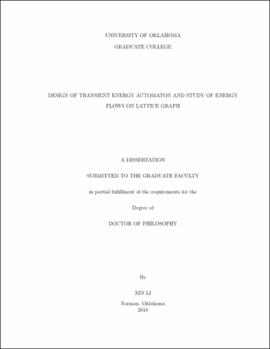| dc.description.abstract | The effort of this doctoral dissertation research is devoted to the design of an automaton system and corresponding computer experiments for studying the dynamics of energy flow on lattice graphs. Such a Transient Energy Automaton (TEA) is a computational system that automates dynamic energy exchanges on a graph once triggered by disturbances similar to those used in the analysis of the dynamics of multi-machine power model system. The differences between TEA and other automata are: 1) TEA considers all of the vertices in the lattice graphs that are connected with each other; 2) TEA supposes the energy exchange processing by two specific actions; 3) TEA defines the governing rules of those actions.
The TEA enables two fundamental actions of energy exchange at each vertex: a slow action to absorb a certain fraction of the energy received from the site of initial disturbance or the neighboring vertices, and a fast action to reflect the rest of the received energy to the rotors or oscillators at neighboring vertices on the graph. These two fundamental actions coupled together to enable the energy flow of TEA.
In order to simplify the coupling of the two actions in the TEA, we let these two fundamental actions at local site or vertex be governed by the following rules:
1. For each vertex, the amount of energy received at a local site in the reflection action, which is defined as dispersion ratio, is a function of the graph geometry including the structure of lattice and value configuration of edges;
2. The fraction of energy that can be absorbed by each vertex in the absorption action, which is defined as absorption ratio, is based on the capability of the vertex;
3. We suppose at a particular time instant, all the vertices are in one same action, either fast action or slow action;
4. Such rules are functions of the geometry and value configuration of graph and the property of vertices, which ultimately enable the TEA to create time evolution of energy distribution, that may affect the dynamics of the system.
The two governing rules apply to the fast and slow actions at the local site or vertex-level by the ratios of dispersion and absorption. The ratios are defined by two major intrinsic factors for the global energy exchange: 1) geometry of graph and its value configuration, and 2) property of vertex. The geometry controls the energy dispersion among vertices according to their propinquities and centralities configured by graph lattice, while the property of vertex is the capability to absorb or reflect the energy received.
The energy distribution among vertices on a graph and its time evolution are computed recursively using the computational formula of the two actions under the governing rules. Moreover, the computation of the accumulated energy at each vertex satisfies an “additive superposition” principle to obtain the homogeneity of energy distribution on graph for each time step and for the time evolution of the process. The global properties of energy flow on a graph can then be investigated by analyzing the functionalities of graph geometry and vertex property at local site or vertex-level, both directly impact the fast and slow actions.
The experiment with TEA concentrates on discovering the linkage between characteristics of graph, such as homogeneously and heterogeneously distributed, and the dynamics of TEA from the local-level or global-level. More specifically, the proposed TEA model system and the experiment approach can simulate energy exchange at each local site or vertex level to obtain the global dynamics of energy flow on graph. Through analyzing energy absorption at vertices in slow actions, energy dispersion over the lattice in fast actions, homogeneity of the energy distribution on graphs, as well as their time evolution, we are able to obtain constructive evidence that energy automation may possibly be a simplifying approach to understanding the global dynamical properties of energy flow on graphs, and more ambitiously, those found in real large-scale energy interconnections.
The automaton model system and the experiment approach exhibits a number of advantages: practically they have a simplifying complex feature in modeling coupled dynamics on the graph to produce global features of large-scale energy interconnections, demanding an extra-low computational burden comparing to those needed to solve Differential-Algebraic Equations of the large-scale system. More importantly, a quick insight into the nature of dynamics on the graph that ordinary methods are inadequate, particularly when there are significant structural changes in graph topology and vertex functionality. | en_US |
